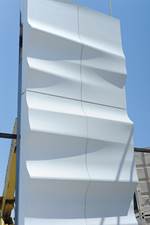The IBC and FRP
HPC editor-in-chief Jeff Sloan marks signs of progress toward the use of composites in high-rise architecture since the International Building Code was amended in 2009 to clearly define code-compliant uses of FRP.
If you’re like me, nine times out of 10 when you tell people what you do for a living, you get back a relatively blank stare. Composites? Manufacturing? Occasionally I’ll get a glimmer of recognition if I mention fiberglass, the Corvette or carbon fiber bikes. And with all of the wind turbines being erected of late, it’s easy to reference those as a major consumer of composite materials.
On rare occasions, however, I’ll run across someone who either has at least some knowledge of composites, or possesses curiosity in sufficient quantities that they are compelled to ask questions: How are composites made? What with? What for? How much? Etc. And among some of these curious folks, I’ll even discover a few people who start thinking about composites’ potential:
“Why don’t we make a car out of composites?” (“They’re working on that.”)
“You could make a composite house!” (“Some people are.”)
“They should make composite helmets.” (“They do.”)
“Composites could be used to build an entire building.” (“Well ….”)
That last one was tough for many years. In theory, composites are well-suited to the business of fabricating shelters — office buildings, shopping centers, factories, museums — that are subjected to the elements that composites combat so well: Gravity, rain, wind, sand, snow, ice, heat, UV radiation and fire. It’s a wonder, then, that composites have, for most of their existence, seen so little use in large building projects.
As is true in some other promising composites markets, the problem was not a lack of composites’ capabilities. It was, in part, that composites are not wood, concrete or glass — the familiar legacy materials that have a long, respected and well-known history sheltering the human race from the elements. More importantly, composites had not been classified as a sanctioned construction material in the International Building Code (IBC), the bible to which the vast majority of architects and building contractors refer when they select materials for a structure.
In 2009, that changed, thanks in the main to the American Composites Manufacturers Assn. (ACMA), which helped lead an effort to define composites in the IBC. Chapter 26 now includes a section on fiber-reinforced polymers and permits their use in interior finish applications, such as walls and ceilings, and in nonstructural exterior assemblies, including curtain walls, cladding and rain screens.
This change is starting to bear fruit. We have two reports this month that address composites use in architecture. One is our report on the American Institute of Architects (AIA) convention this summer (click on "AIA 2014 Convention report," under "Editor's Picks," at top right). The other, tiled "Architectural composites: Rising to new challenges," also under "Editor's Picks," highlights several recent composites construction applications that are now in progress. The value of these applications is not trivial: Their size, scope and ambition means they will be seen and, ideally, admired and emulated. And in this way the composites industry evolves and grows and matures just a little more.
Related Content
-
How composites have become a necessity
Composites used to be one of many material options across industries and applications, but that's not the case anymore.
-
Sustainability has come to composites and it's here to stay
It might be tempting to think of sustainability as a buzzword, but there are structural changes taking place in the composites industry that signal its permanence.
-
What to make of the first JEC World in three years
CW went to JEC World 2022 not sure what to expect. We were pleasantly surprised, and learned much about where and how new composites technologies are being developed.










.jpg;maxWidth=300;quality=90)





